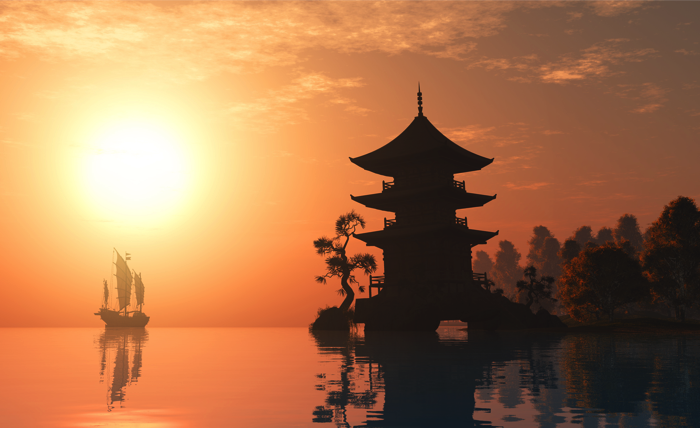Translated By Andrew Yang
The water in today’s river is no longer water of yesterday’s river,
Nor that of the river tomorrow.
The biggest revelation of Chan for practitioners is in helping one attain Buddhahood, whereas the impact of poetry is in giving vent to one’s emotions. While Buddhahood is an inherent entity belonging to the true mind, emotions are what one has that belong to an illusory mind. Thus, as they originate in the one mind, whether Chan or poetry, they both flow out of what one feels personally. Occasionally, a contemplative verse speaks of one’s aspiration through things mundane or lays bare their pursuit of mental clarity. In the meantime, it may also contain truth of life attained through the acquiring of Chan.
Zhang Ruoxu (c. 660-c. 720) of the Tang dynasty (618-907) wrote Spring River with Blooms on a Moonlit Night, a well-liked poem teeming with connotations of Chan. Below, let me share with you part of this elegant piece by a somewhat enigmatic poet.
The poem says,
Not a speck of dust from sky over river in one colour. Glistening is the lone moon hanging up high.
Who first ever beheld a moon on the river? In which year did a moon on the river first shine nigh?
Generation upon generation, endlessly humans populate. Year after year, alike are moon and river.
It’s not known who river and moon await, except that the long river gives a send-off to its water.
Reading the poem’s title itself is captivating enough. The five things, spring, river, flowers, moon and night, well embody a most enjoyable moment in life, with a finest landscape and a wonderous artistic scene that charms and enchants.
“Not a speck of dust from sky over river in one colour. Glistening is the lone moon hanging up high.” On a spring night, rapt in pristine moonshine, the poet marvels at its splendor. The river water, blending into one hue with the nocturnal sky, paints a vista of absolute purity as a backdrop to an immaculate moon while embracing feelings of solitude and the unique scent of life given forth by the moon.
“Who first ever beheld a moon on the river? In which year did a moon on the river first shine nigh?” With a translucent moon hanging high above, imagine who among those on a riverbank first ever spotted it, or when it started shining on men. These are, of course, rhetorical questions without answers. They are no more than a writer’s fanciful search for secrets of an elusive universe, much like a philosopher who probes the origin of life, enquiring how the cosmos was formed and what started human life. These have been perennial questions without a definitive answer, and indeed quite a mystery ever since time immemorial.
“Generation upon generation, endlessly humans populate. Year after year, alike are moon and river.” Human beings reproduce generation after generation while the moon over the river seems to have remained the same year in year out. After all, a human being’s life is short and impermanent, whereas the moon always rises in an ocean and always shines in the sky, forever orbiting as time elapses.
As a matter of fact, the spring, river, flowers, moon and the night, they are all dharmas of conditioned origination. On the surface, they may appear to be everlasting, and yet being devoid of an intrinsic nature they are not eternal. The Diamond Sutra points out, “All appearances are illusory. If one sees that appearances are not what they appear to be, he sees Tathagata.” Those who learn to practise contemplating that all dharmas are a void, are not deluded by the triggering environment they inhabit. Thus, the poem goes on to say that the past river water is gone for good, the present river water is still flowing, and the future river water is yet to arrive. In this way, will the past, present and future water of the river have a moment to pause? Today’s water of the river is not yesterday water of the river, and will not be tomorrow’s water of the river. It only appears to be the same water.
“It’s not known who river and moon await, except that the long river gives a send-off to its water.” The poet continues with a surprising question, Has the moon over the river been anticipating someone? In fact, the solitary moon is not expecting anybody. As humans, we are all perpetual passing sojourners, and the moon has merely been watching the river flow by day after day.
The poem, in rendering the interval from moonrise to moonset and merging fantasy into scenes of reality, reads mystifying and enrapturing. Step by step, its emotional vibes increasingly unfold and move with the shifting moonlit scenery, fusing the real and the fanciful but never fixating upon any one sight. Sometimes the reader feels as if its message is too elusive to pinpoint, but they also sense that its import is worth exploring in depth. Such is at once, perhaps, the wonder of human life and its attendant misery involving impermanence and fleetingness in, for instance, departing from loved ones.
Many ancient poets have left behind immortal, pensive verses wondering about the ceaseless change of the universe, including the archetypal lunation over a clear sky. In his Querying the Moon over Wine, the legendary Tang poet Li Bai (701-762) writes, “People today do not see an ancient moon, but today’s moon once did illuminate ancient folk. Men in our day and of yore are much like flowing water, as are the bright moon on the deep”. The poem we have been enjoying, Spring River with Blooms on a Moonlit Night, comprises five select images of nature that make up a gorgeous, ethereal scene, compelling the reader to both admire Mother Nature’s beauty and at the same time ponder over big questions concerning impermanence, suffering and futility. It is indeed a wistful elegiac lament about humanity without compare.

